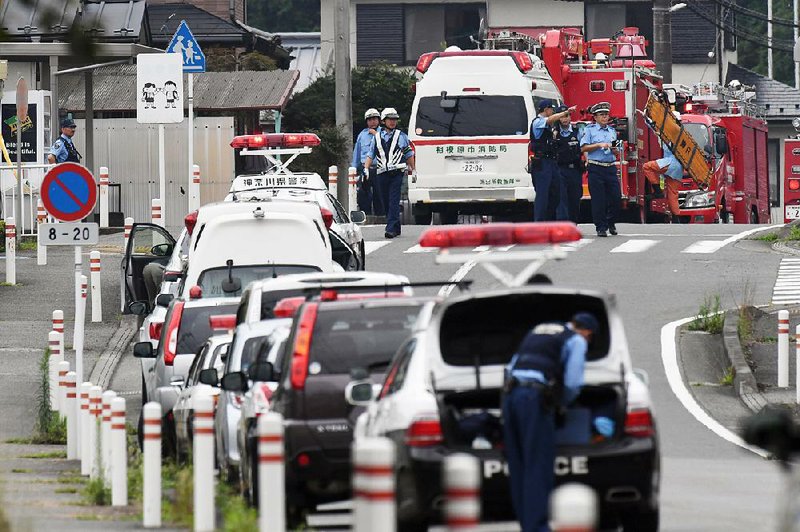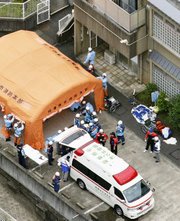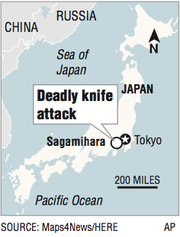TOKYO -- At least 19 people were killed and about 20 wounded in a knife attack Tuesday at a facility for the handicapped in Tokyo suburb in a rare case of mass violence in Japan, according to Japanese media reports.
Police said they responded to a call about 2:30 a.m. from an employee saying that something horrible was happening at the facility in Sagamihara, just west of Tokyo.
A man surrendered at a police station about two hours later, police in Sagamihara said. He left a knife in his car when he entered the station. He was arrested on suspicion of attempted murder and trespassing.
"I did it," the man told police when charged with murder, Japan's national broadcaster NHK reported.
Officials in Kanagawa prefecture, which borders Tokyo, identified the suspect as Satoshi Uematsu, and said he had worked at the Tsukui Yamayuri-en facility, where the stabbings took place, until February. It was not clear why he left. Japanese media reports said he was 26 years old.
He told police that he was angry at losing his job at the facility, according to local TV reports. "It's better that disabled people disappear," the police quoted him as saying, according to local reports.
He entered the building about 2:10 a.m. by breaking a glass window on the first floor of a residential building at the facility, Shinya Sakuma, head of prefectural health and welfare division, said at a news conference.
Uematsu was said to use a hammer to break the window, Nippon TV reported. The attacker started stabbing residents but was apprehended by a staff member whom the attacker apparently overcame and tied up and from whom the assailant snatched keys before going on to stab more people, Nippon TV reported. NHK said a hammer was found, a window was broken at the facility and the knife was in Uematsu's car outside the police station.
Kanagawa Gov. Yuji Kuroiwa expressed his condolences to the victims.
The attack was among the worst single-perpetrator mass murders in the post-World War II era.
The Sagamihara Fire Department said 19 people were confirmed dead in the attack. The department said doctors at the scene confirmed the deaths. Media reports from NHK and Kyodo News said 20 were wounded.
Another report put the number of injured as high as 45.
Among the injured, at least 13 people were in critical condition and were taken to hospitals in Kanagawa prefecture and in Tokyo, the media reports said.
Nine of the dead were men, and 10 were women.
Kiyoshi Nakatsuka, 73, the vice chairman of the parents' group for residents at the center, said his son, in his 40s, was lucky enough to escape the killings, NHK reported. Nakatsuka said many other family members were waiting to hear about their relatives. He had never heard of Uematsu or of any problems with other employees, he said.
Television footage showed a number of ambulances parked outside the facility, with medical and other rescue workers running in and out.
A woman who lives across from the facility told NHK that she saw police cars enter the facility around 3:30 a.m.
"I was told by a policeman to stay inside my house, as it could be dangerous," she said. "Then ambulances began arriving, and blood-covered people were taken away."
The facility was built by the prefectural authorities and is run by a social welfare service organization called Kanagawa Kyodokai. The people who live there have a wide range of mental and physical disabilities. Some can walk and do outside activities, while others are bedridden.
The Tsukui Yamayuri-en facility provides both residential accommodation and day care and has a swimming pool, gym and medical clinic. It has 149 residents between the ages of 18 and 75, and eight staff members normally work at the facility overnight, NHK reported. Thirty-two of the residents have lived at the center for more than 30 years.
Mass killings are relatively rare in Japan, which has extremely strict gun-control laws. The country had just one gun death last year. Just eight crimes were committed in 2015 that involved gunfire, according to police.
But there have been occasional high-profile stabbings, including one in 2008 in which seven people were killed by a man who slammed a truck into a crowd of people in central Tokyo's Akihabara electronics district and then stabbed passers-by.
Fourteen were injured in 2010 by an unemployed man who stabbed and beat up passengers on two public buses outside a Japanese train station in Ibaraki prefecture, about 25 miles northeast of Tokyo.
The death toll in Tuesday's rampage was higher than in the 1995 sarin gas attack on the Tokyo subway, carried out by members of the Aum Shinrikyo cult, in which 12 people were killed and 50 severely injured.
Sagamihara last made international news in 2012, when one of the suspects in the gas attack was arrested there.
Naoko Kikuchi, one of the most wanted people in Japan for her involvement in the attacks, had been hiding in the city under the name Chizuko Sakurai.
Information for this article was contributed by Mari Yamaguchi and Satoshi Sugiyama of The Associated Press; by Anna Fifield and Yuki Oda of The Washington Post; and by Motoko Rich, Makiko Inoue, Jonathan Soble and Karen Zraick of The New York Times.
A Section on 07/26/2016


